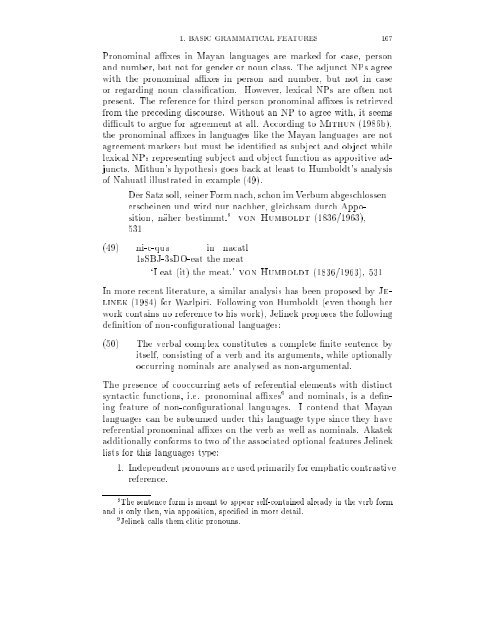Perception verb complements in Akatek, a Mayan language
Perception verb complements in Akatek, a Mayan language
Perception verb complements in Akatek, a Mayan language
You also want an ePaper? Increase the reach of your titles
YUMPU automatically turns print PDFs into web optimized ePapers that Google loves.
1. BASIC GRAMMATICAL FEATURES 107<br />
Pronom<strong>in</strong>al a xes <strong>in</strong> <strong>Mayan</strong> <strong>language</strong>s are marked for case, person<br />
and number, but not for gender or noun class. The adjunct NPs agree<br />
with the pronom<strong>in</strong>al a xes <strong>in</strong> person and number, but not <strong>in</strong> case<br />
or regard<strong>in</strong>g noun classi cation. However, lexical NPs are often not<br />
present. The reference for third person pronom<strong>in</strong>al a xes is retrieved<br />
from the preced<strong>in</strong>g discourse. Without an NP to agree with, it seems<br />
di cult to argue for agreement at all. Accord<strong>in</strong>g to Mithun (1986b),<br />
the pronom<strong>in</strong>al a xes <strong>in</strong> <strong>language</strong>s like the <strong>Mayan</strong> <strong>language</strong>s are not<br />
agreement markers but must be identi ed as subject and object while<br />
lexical NPs represent<strong>in</strong>g subject and object function as appositive adjuncts.<br />
Mithun's hypothesis goes back at least to Humboldt's analysis<br />
of Nahuatl illustrated <strong>in</strong> example (49).<br />
Der Satz soll, se<strong>in</strong>er Form nach, schon im Verbum abgeschlossen<br />
ersche<strong>in</strong>en und wird nur nachher, gleichsam durch Apposition,<br />
naher bestimmt. 8 von Humboldt (1836/1963),<br />
531<br />
(49) ni-c-qua <strong>in</strong> nacatl<br />
1sSBJ-3sDO-eat the meat<br />
`I eat (it) the meat.' von Humboldt (1836/1963), 531<br />
In more recent literature, a similar analysis has been proposed by Jel<strong>in</strong>ek<br />
(1984) for Warlpiri. Follow<strong>in</strong>g von Humboldt (even though her<br />
work conta<strong>in</strong>s no reference to his work), Jel<strong>in</strong>ek proposes the follow<strong>in</strong>g<br />
de nition of non-con gurational <strong>language</strong>s:<br />
(50) The <strong>verb</strong>al complex constitutes a complete nite sentence by<br />
itself, consist<strong>in</strong>g of a <strong>verb</strong> and its arguments, while optionally<br />
occurr<strong>in</strong>g nom<strong>in</strong>als are analysed as non-argumental.<br />
The presence of cooccurr<strong>in</strong>g sets of referential elements with dist<strong>in</strong>ct<br />
syntactic functions, i.e. pronom<strong>in</strong>al a xes 9 and nom<strong>in</strong>als, is a de n<strong>in</strong>g<br />
feature of non-con gurational <strong>language</strong>s. I contend that <strong>Mayan</strong><br />
<strong>language</strong>s can be subsumed under this <strong>language</strong> type s<strong>in</strong>ce they have<br />
referential pronom<strong>in</strong>al a xes on the <strong>verb</strong> as well as nom<strong>in</strong>als. <strong>Akatek</strong><br />
additionally conforms to two of the associated optional features Jel<strong>in</strong>ek<br />
lists for this <strong>language</strong>s type:<br />
1. Independent pronouns are used primarily for emphatic contrastive<br />
reference.<br />
8 The sentence form is meant to appear self-conta<strong>in</strong>ed already <strong>in</strong> the <strong>verb</strong> form<br />
and is only then, via apposition, speci ed <strong>in</strong> more detail.<br />
9 Jel<strong>in</strong>ek calls them clitic pronouns.

















